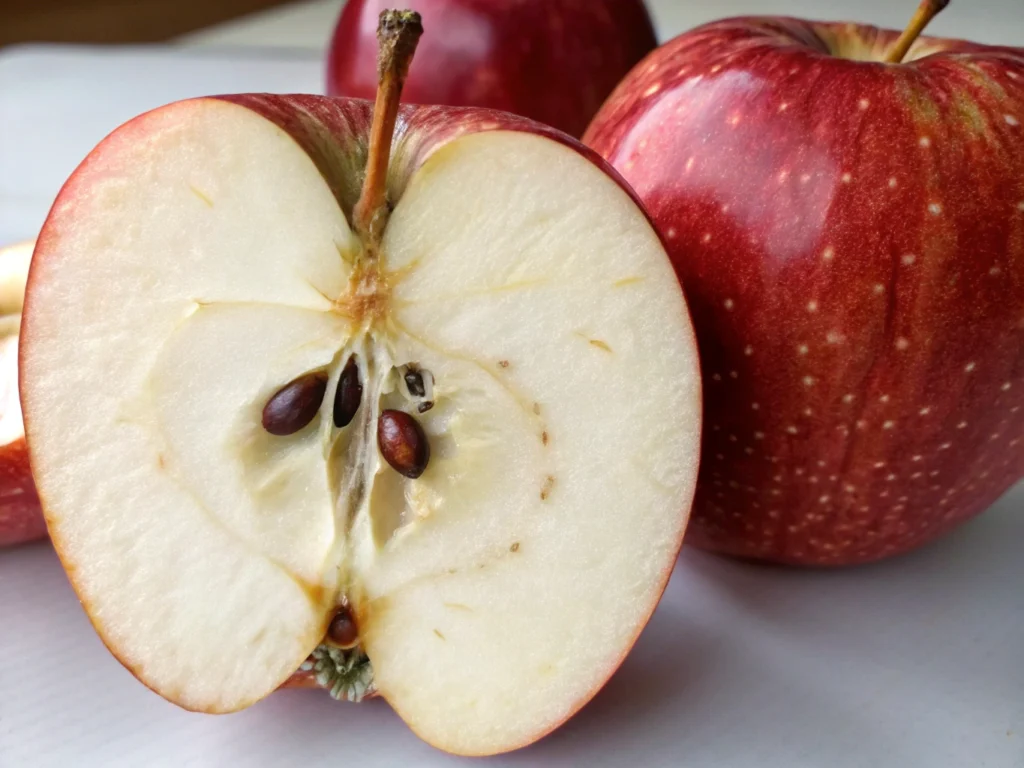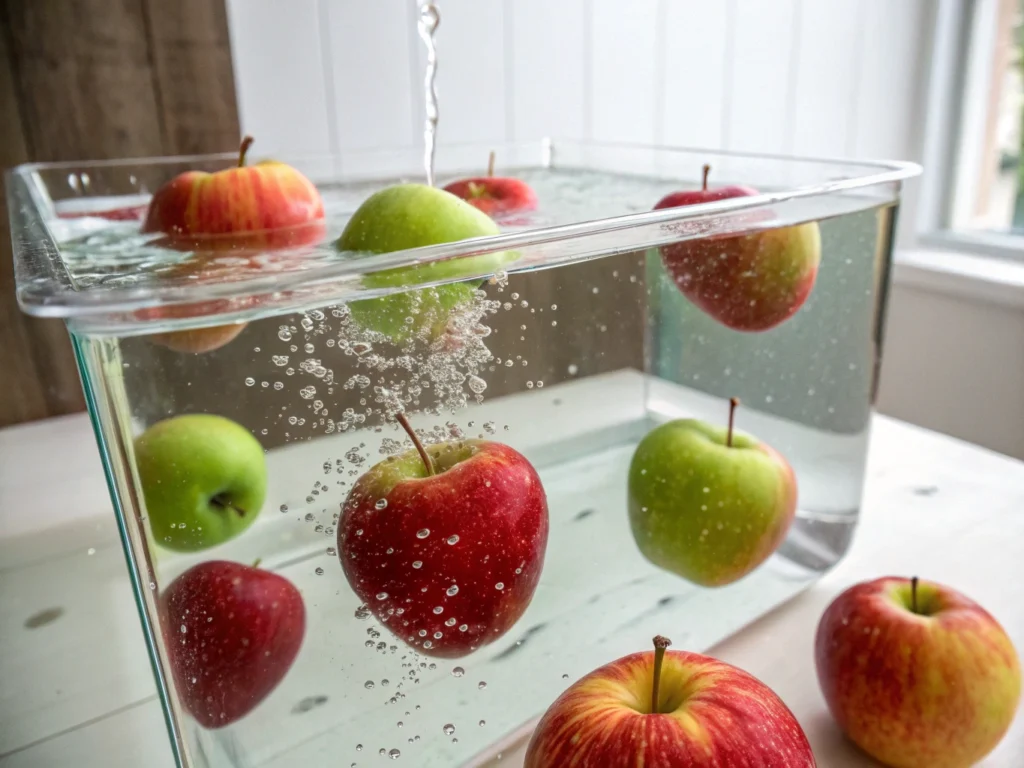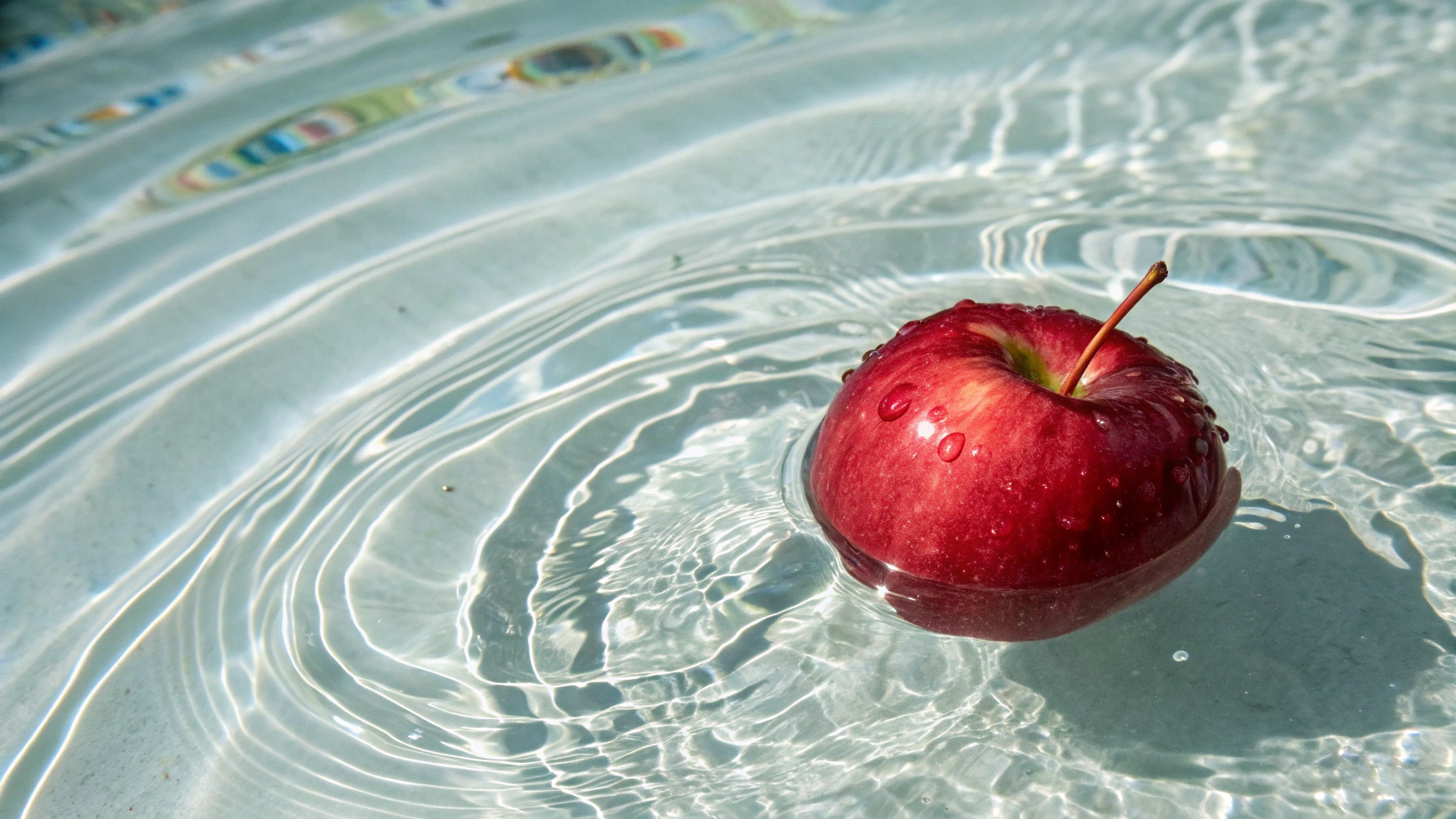Apples floating in water might seem like a simple observation, but have you ever wondered what makes an apple float? This fascinating phenomenon is rooted in the principles of buoyancy and the unique structure of apples. From tiny air pockets inside their flesh to their density relative to water, the science behind floating apples reveals a lot about nature. Let’s dive into the details of this intriguing topic, exploring its science, cultural significance, and practical applications!
Understanding What Makes an Apple Float
What Does Buoyancy Mean for Floating Apples?
Buoyancy is the upward force exerted by a fluid that allows objects to float. In simpler terms, it’s why boats, balloons, and even apples don’t sink when placed in water. An object floats if the upward force of water is greater than the object’s weight.
Think about it: when you place an apple in water, it displaces a certain amount of liquid. If the weight of the displaced water is more than the weight of the apple, the apple will float. This phenomenon, though simple in concept, has intrigued scientists and laypeople for centuries.
How Density Explains Why Apples Float
At the heart of buoyancy lies density. Density is the mass of an object relative to its volume. Water has a density of 1 gram per cubic centimeter (g/cm³). If an object has a density less than water, it floats.
Apples, on average, have a density slightly below 1 g/cm³. This is primarily due to their unique structure, which contains air pockets. These pockets reduce the overall density, allowing the apple to stay afloat.
Relation to Archimedes’ Principle
This floating behavior aligns with Archimedes’ principle. According to this principle, an object submerged in a fluid experiences an upward force equal to the weight of the fluid it displaces.
In the case of apples, their composition ensures that the displaced water’s weight is higher than their own. This is why they bob happily on the water’s surface! Understanding these basics sets the stage for exploring what makes apples uniquely buoyant.
The Composition of an Apple
Anatomy of an Apple: Key Components

To understand what makes an apple float, we need to look inside. An apple is made up of three main parts: the peel, the flesh, and the core. Each part plays a role in its overall structure and behavior in water.
The peel, though thin, provides a protective barrier that helps the apple maintain its shape. Beneath the peel lies the flesh, which contains water, sugars, and tiny air spaces. At the center is the core, which houses the seeds and provides structural support.
This unique combination of materials—especially the presence of air—makes apples naturally less dense than water. Without these characteristics, apples would sink like stones!
Exploring What Makes an Apple Float: Air Pockets and More
The real answer to what makes an apple float lies in its air pockets. These tiny spaces are found throughout the apple’s flesh and make up roughly 25% of its volume. Air is much lighter than water, so these pockets act like built-in flotation devices.
When an apple is submerged, the water it displaces weighs more than the apple itself. This imbalance causes the apple to rise back to the surface. Interestingly, apples with more air pockets float more easily, while those with fewer may hover just below the surface.
Water Content in Apples: A Key to Floating
Although apples are about 84% water by weight, their density is still slightly lower than water. Why? It’s all about the balance between water and air. The high water content keeps apples fresh and crisp, while the air spaces reduce the overall density.
This delicate balance is crucial. If an apple absorbs too much water—say, from being overripe or damaged—it might lose its buoyancy and sink. This interplay of water, air, and structure perfectly explains what makes an apple float.
Experimenting with Apples: Do All Apples Float?
Apple Varieties and Floating Behavior
Not all apples float the same way. Different varieties, like Honeycrisp, Granny Smith, and Red Delicious, have slightly different densities due to variations in their water content, sugar levels, and air pocket distribution.
For example, Honeycrisp apples are known for their crisp texture and high air content, making them excellent floaters. On the other hand, denser apples like Fuji or Gala may sit lower in the water, but they still float. This variation shows that while all apples follow the same buoyancy principle, their specific properties can influence how they behave in water.
Simple Tests to Discover Why Apples Float

Want to see what makes an apple float firsthand? Try this simple experiment:
- Fill a bowl with water.
- Place an apple in the water. Observe how it floats.
- Now, cut the apple into slices and place them in the water. Notice any differences?
When the apple is whole, the air pockets remain intact, keeping it afloat. But once it’s sliced, the water replaces the air spaces, and the pieces may start to sink.
You can also test different apple varieties to see which floats the highest. This is a fun way to explore density and buoyancy with minimal effort!
Factors That Change What Makes an Apple Float
While most apples float, certain factors can make them sink. Overripe apples, for instance, often lose air as their flesh becomes softer and more compact. Damaged or bruised apples may also absorb water, increasing their density and making them less buoyant.
Interestingly, apples stored for long periods can lose some of their air pockets through dehydration. Without these pockets, the balance between air and water shifts, and the apple’s ability to float diminishes.
These experiments and observations highlight the delicate interplay between structure and environment that determines what makes an apple float.
Historical and Cultural Significance of Floating Apples
Traditions Linked to Why Apples Float in Water
Floating apples have a surprising cultural connection, particularly in autumn traditions. Ever heard of apple bobbing? This popular game traces its roots to ancient harvest festivals where apples symbolized fertility and fortune. Participants would try to catch floating apples with their teeth, a fun activity that celebrates the fruit’s natural buoyancy.
Apples were often seen as mystical in folklore. Their ability to float added an element of mystery, symbolizing lightness and purity in various cultures. Today, these traditions continue as a charming nod to history, making what makes an apple float more than just a scientific curiosity.
Floating Apples in Folklore and Their Symbolism

In many cultures, the apple is associated with abundance, health, and even love. Its buoyancy was often seen as a metaphor for resilience and adaptability. People believed that apples floating at the top of a barrel could predict future prosperity or relationships.
These symbolic interpretations add depth to the question of what makes an apple float. While science explains it with density and air pockets, cultural perspectives imbue it with a sense of wonder.
For more delicious recipes, check out Green Apple Float Recipe on our partner website!
Environmental and Practical Implications
Using What Makes an Apple Float in Agriculture
Understanding what makes an apple float isn’t just fun trivia—it has practical applications, especially in agriculture. Farmers and distributors often use water baths to sort apples. Floating apples are typically healthier, less dense, and better suited for storage and sale.
This method is efficient and eco-friendly, as it relies on the natural properties of apples without the need for complex machinery. By leveraging the buoyancy principle, farmers can ensure only the best apples reach consumers.
Sustainability and Floating Apples: An Eco-Friendly Approach
Floating apples also remind us of the importance of sustainability. Water is a critical resource in agriculture, and its use in sorting apples demonstrates a balance between necessity and conservation. Moreover, buoyancy testing helps reduce food waste by identifying apples that may be too overripe or damaged for sale.
While science tells us what makes an apple float, this natural phenomenon also serves as a practical and environmentally conscious solution in the food industry.
Exploring the Science of Other Floating Fruits
What Makes an Apple Float vs. Other Fruits
While the question what makes an apple float? is fascinating, apples aren’t the only fruits with buoyant properties. Many fruits, such as oranges and watermelons, can float too. Their ability to stay afloat also depends on density and internal air pockets.
For example, oranges with their peel intact float because the peel traps air, reducing overall density. If you remove the peel, the orange sinks as it becomes denser than water. Similarly, watermelons float due to their high water content and internal structure, which resembles a network of tiny air chambers.
Why Some Fruits Sink While Apples Float
Fruits like bananas and grapes, however, typically sink. Their lack of significant air pockets and higher density means they can’t displace enough water to stay afloat. This highlights how the unique structure of an apple—its balance of water and air—sets it apart.
By comparing apples to other fruits, we can better appreciate the specific factors contributing to their buoyancy. The next time you see fruit floating in water, remember the science behind it isn’t limited to apples but applies to a variety of produce!
Frequently Asked Questions About Apple Buoyancy (250 words)
Common Questions: Why Do Apples Float and Pears Sink?
This is a common question related to what makes an apple float. The answer lies in density and structure. Apples have significant air pockets that reduce their density, allowing them to float. Pears, on the other hand, are denser with less air, causing them to sink.
Does Floating Indicate Freshness in Apples?
Yes and no. While a floating apple is often fresh, other factors like variety and ripeness also play a role. Overripe apples may still float, but they lack the crispness of fresher ones. Testing buoyancy can give clues but isn’t a foolproof indicator of quality.
How Air Pockets Explain What Makes an Apple Float
Cutting an apple exposes its internal air pockets to water. As water replaces the air, the slices often lose buoyancy and sink. This simple experiment demonstrates the importance of air in answering what makes an apple float.
Conclusion: The Science and Wonder Behind Floating Apples
The question what makes an apple float? reveals much more than meets the eye. By exploring the science of buoyancy, density, and the unique composition of apples, we’ve uncovered the key factors that keep this beloved fruit bobbing on the water’s surface. From the microscopic air pockets within their flesh to their cultural and practical significance, apples demonstrate a perfect harmony between nature and physics.
Moreover, floating apples serve as a gateway to understanding broader scientific principles and their applications. Whether you’re experimenting at home, pondering the mystery of other floating fruits, or appreciating the apple’s role in agriculture and tradition, this natural phenomenon invites curiosity and learning.
So the next time you drop an apple into water and see it float, you’ll know there’s a world of science, history, and wonder behind that simple act.

